I was both surprised and more than a little pessimistic when I heard that Halo Wars 2 was in development for the Xbox One. It seems that neither my observations about the first game’s questionable intended audience or its odd, semi-forgotten place in the Halo series necessarily correlated with low sales numbers. Still, I’m curious about what inspired them to make Halo Wars 2 beyond 343 Industries’ continued efforts to grow and diversify the franchise, particularly with Ensemble out of the picture. Speaking of, Halo Wars 2 would be developed by another studio with some serious strategy game credentials, Creative Assembly, best known for their Total War series. Likely pretty exciting for fans of the first game, though, like I mentioned in my Halo 5 post, I was out of the loop on all things Xbox for much of that generation.
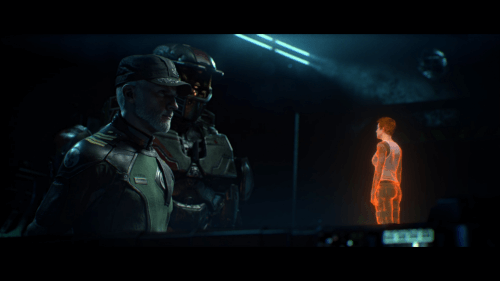
“Capt. Cutter and Jerome-092 are back, along with a new friend.”
Immediately upon loading the game up I was struck by its presentation, as extremely close-up shots of units in combat cycle in the background showcasing a change in both art direction and graphical fidelity; the further you zoom in the more the individual units start to look cartoonishly stylized, almost appearing like figurines from a tabletop wargame. Then we have the pre-rendered cutscenes. Oh my! Blur is back and their work here is top-tier, even more impressive than in the original Halo Wars.
Hopping into my first mission I was struck by how much better the effects, animations, and particularly the environments looked than in the first game. As for the units, Halo Wars 2 sticks with designs much closer to those of the original Halo trilogy than 343’s later revisions. Whether this was an attempt to appease older fans or simply justified for the in-universe reason that the Spirit of Fire and her crew had been drifting since before Halo: CE (and without any fancy nanomachine upgrades) I don’t know, but I appreciate it in any case. About my only complaint is that, unlike in the original Halo Wars, your units are all colored with the multiplayer forest green color rather than the typical olive green we associate with the Master Chief. A total nitpick, I admit.
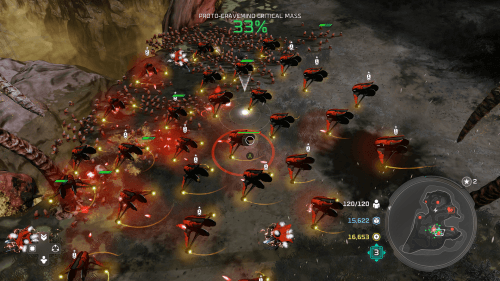
“The Flood aren’t the only ones who can field ridiculous numbers of the same unit.”
The UI has been totally overhauled, and while many of the controller bindings and interface concepts are the same as in the first game, they’ve definitely been improved and expanded upon, particularly when it comes to unit selection. In the end, I still relied mostly on the basic controls of selecting every unit, all units on the screen, or units of a particular type rather than grouping them more strategically as I might in a PC RTS. As such, there were points at which I returned to the cheesy strategy of massing a single type of unit, most notably fully upgraded Banshees when playing the last few missions of the Awakening the Nightmare expansion.
As with the first game, I opted to lower my difficulty level down to “Normal” in the interest of keeping my playthrough from being too laborious, but while there were definitely still a few difficult spots where I found myself caught in a bit of a grind against unit attrition and/or base defense versus exploration or aggressively seeking out objectives, overall it felt a little less challenging, at least until I got to the DLC content. I still find the unit constraints and other limitations many campaign missions force on you to be pretty annoying, but this is typical of single player campaigns in RTS games, and I at least found some of these scenarios, particularly the mission “Hold the Line” (a straight-up tower defense ripoff) to be pretty fun.
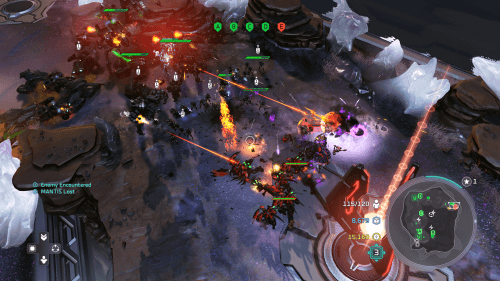
“A huge UNSC combined force claiming a Forerunner structure.”
Now let’s talk about the story. As this is a side story without too much relation to the main series, I’ll go ahead and recap the plot of Halo War 2’s campaign and its two DLC expansions. I try to be somewhat vague in these plot summaries but they absolutely do still contain spoilers, so skip the three paragraphs if you don’t want the plot to be spoiled!
The Story: After drifting for 28 years the Spirit of Fire’s crew awakens to find themselves orbiting an enormous Forerunner installation in uncharted space. Spartan Red Team and a small recon squad are soon dispatched to the surface to investigate the source of an encrypted UNSC transmission. There they find the battle-scarred ruins of a small UNSC science outpost and its still-active AI, Isabel. Isabel tells Captain Cutter and his officers about the installation they’re on, the Ark, and the Banished, a powerful mercenary army made up of Covenant remnants and led by the Brute warlord Atriox, who have occupied it. Determined to stay and fight, Cutter begins deploying forces planetside, successfully executing a series of strikes against Banished bases. Enraged by these losses, the Banished send their flagship, Enduring Conviction, to engage the Spirit of Fire directly. With the Spirit of Fire only temporarily able to fend off the Enduring Conviction, Isabel enacts a cunning plan to gain access to the flagship’s systems and attack the Ark, causing the installation’s Sentinel drones to attack the ship en masse, quickly crippling it. Meanwhile, Professor Anders comes up with her own cunning plan to regain contact with the UNSC. Launching a reserve Halo ring from the Ark’s Foundry, Anders plans to plant a beacon in its control room before it jumps to the site of the destroyed Installation 04, hopefully close enough to UNSC space to be detected. After repelling a Banished assault on the newly launched ring, Anders, while successful, is unable to escape the ring’s control room before it jumps. Sometime later while Cutter and Atriox plan their next moves in the war for control of the Ark, the ring drops out of slipspace. Investigating, Anders comes face to face with a Guardian.
Set one month later, Operation SPEARBREAKER follows a squad of ODST as they lead an operation to stop the now stranded Banished from activating a Forerunner fighter and using it to destroy the Spirit of Fire. Caught between UNSC forces and the Ark’s own considerable Sentinel defenses, the Banished plan is ultimately foiled.
Set several months later still, Awakening the Nightmare shows the war from the perspective of the Banished. With the loss of the Enduring Conviction, Banished forces must scour the Ark for supplies and other resources to keep up their war against the Spirit of Fire. During such a mission, two of Atriox’s lieutenants, brothers Voridus and Pavium, violate direct orders and penetrate the crashed High Charity’s defenses, unwittingly unleashing the previously quarantined Flood. The Flood rapidly spread across the Ark, infecting Banished and UNSC troops alike, with every plan the brothers concoct to halt their advance being decisively defeated. Soon the existence of a Proto-Gravemind is discovered and, running out of options, the brothers make a concentrated effort to destroy it. Thanks to this massive coordinated strike, Voridus and Pavium succeed, and at Atriox’s order, turn to cleaning up the remaining Flood.
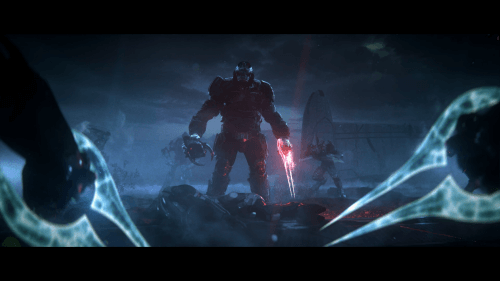
“Atriox, Warmaster of the Banished, throwing off the Covenant’s yoke.”
First, I have to say that I liked Halo Wars 2’s story a hell of a lot more than some other recent entries in the franchise. It feels more original than that of the first Halo Wars while also being grounded enough to not require you to be a scholar of expanded lore to appreciate (looking at you, Halo 4.) To that end, you’re never left scratching your head about who the antagonists are either. In fact, Atriox and his Banished are introduced with a detailed backstory right up front, and the awesome cutscene in question should be required viewing for anyone playing Halo Infinite. I also love that the Spartans of Red Team now have a lot more personality so we can like them for more than just being ridiculously effective, and despite me just saying that, they don’t feel like invincible superheroes either, with one of them getting messed up bad during the very first encounter with the Banished. Between that and Isabel’s almost palpable fear of Atriox when you first meet her, I felt like I was set on my back foot from the start. My only real disappointment is the end of the campaign, which never fully resolves the conflict at the core of the story, even with the addition of two DLC campaigns that extend the timeline. To be continued, I suppose, and likely in a book or a comic rather than another game. *sigh*
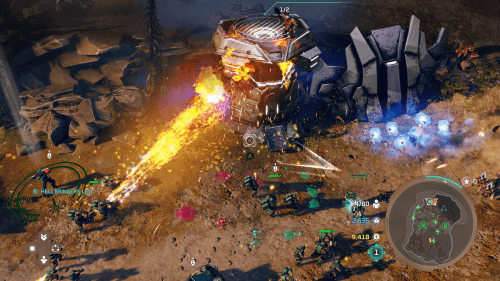
“Hellbringers roasting some garrisoned Brutes.”
To wrap up, Halo Wars 2 feels like a good sequel, retaining the feel of the first game with expected iterative refinements to gameplay, technology, and practically everything, really, along with the level of polished presentation you’d expect from a Halo game. It honestly blows my mind that the first Halo Wars managed to be good, but for Halo Wars 2 to come out 8 years later with a completely different dev team at the helm and also be good? Kind of amazing. So, it goes without saying that if you were a fan of Halo Wars, you shouldn’t hesitate to give Halo Wars 2 a spin. If you tried Halo Wars and didn’t like it, on the other hand, there’s probably nothing compelling for you here outside of a quick watch of the cutscenes.
Oh hey, it’s bonus live-action media time again! While Halo Wars 2 did have the usual barrage of promotional and marketing content from 343, the only real live-action content were these two ads which, while having very little to do with efforts to make a Halo movie or television series, did at least get a chuckle out of me. More of this, please!